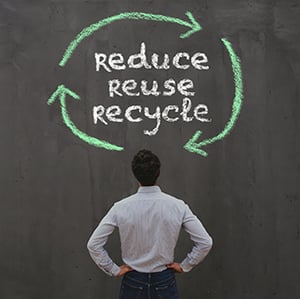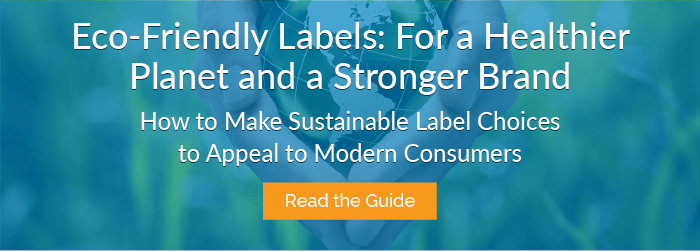
More and more brands are making the switch to sustainable packaging—and for good reason. It’s not just about helping the planet; it’s about connecting with the growing number of consumers who actually care where their products come from.
In fact, 81% of global consumers feel strongly about businesses prioritizing sustainability. So, if your brand isn’t already thinking about sustainable packaging (including your labels), it’s time to start.
But here’s the thing—"sustainable" means a lot of different things when it comes to labels. Is it about recyclability? Compostability? The materials used? The adhesives?
To figure out the best approach for your brand, start by asking yourself these five key questions:
1. How Can My Label Meet Performance Needs While Staying Sustainable?
 Your label isn’t just there to look good—it has a job to do. Maybe it needs to withstand moisture, stick to unusually shaped packaging, or meet regulatory requirements. The challenge is finding a sustainable option that still does the job well. After all, all the time and money you put into your label won’t help you much if it falls off.
Your label isn’t just there to look good—it has a job to do. Maybe it needs to withstand moisture, stick to unusually shaped packaging, or meet regulatory requirements. The challenge is finding a sustainable option that still does the job well. After all, all the time and money you put into your label won’t help you much if it falls off.
The good news? Eco-friendly labels have come a long way. There are waterproof options, biodegradable adhesives, and labels made from post-consumer recycled materials that perform just as well as traditional labels.
So before picking the most “green” option, think about where your product is used and stored. If it’s going to live in a steamy bathroom or a damp wine cellar, a compostable paper label might not hold up. But don’t worry—there are plenty of sustainable alternatives that will.
2. How Do You Define ‘Sustainable’?
More often than not, when customers ask us about sustainable labels here at the Label Printers, they’re referring to recyclable (or recycled) label materials.
You can definitely make your label more sustainable by making it recyclable or using recycled materials. But sustainability can mean so much more than recycling.
Leading environmental advocates now think about products – and by extension, product packaging – in terms of a “circular economy.” The circular economy, as defined by the Ellen MacArthur Foundation, “is based on the principles of designing out waste and pollution, keeping products and materials in use, and regenerating natural systems.”

The opposite of the circular economy is the linear economy. In this model, the Earth’s resources are used to make products, people use the products, and the products are discarded when they’re no longer wanted.
The good news: the design choices we make can actually contribute to a more circular, sustainable economy.
Here are a few ways your product label can help your product become more sustainable:
Encouraging Reusability
Reusability is the gold standard of the circular economy. When we reuse products, nothing goes to waste.
One way to encourage people to reuse your product packaging is by making your label removable. (Your label printer can help you with this.) Certain types of packaging, such as glass jars or sturdy boxes, make attractive household containers, but not when they’re marred by gummy residue or shredded bits of label material.
Reducing Resources
The larger your label, the more resources it consumes. So, before you decide on a size, ask yourself: how big does it really have to be?
You can shrink your label’s footprint by removing text and directing your customers to more information online using QR codes or web addresses. You can also conserve ink by opting for just a few bold colors. In our experience, the consumers who value sustainability also tend to appreciate the art of minimalism.
 Promoting Recycling
Promoting Recycling
Recycling is important, but it’s not always the top choice when it comes to waste management—reducing and reusing are usually more effective. While recycling does help cut down on waste, it still requires energy for the process and for transporting materials. Plus, not all plastic packaging gets recycled everywhere since recycling systems and how well people follow guidelines can differ by location.
With that in mind, your product label can encourage recycling by communicating the recycling process clearly to your customers (more on that below). You can also support recycling efficiency by choosing label materials, inks and adhesives that will not gum up the works at recycling facilities.
For more tips on creating recyclable product packaging, check out this guide from the Association of Plastic Recyclers.
Supporting Composting
Compostable product packaging is growing in popularity. If your product packaging is compostable, remember to choose label material and adhesive that will also biodegrade. Otherwise, that eco-friendly packaging you worked so hard to source could still leave behind waste! Certifications like OK Compost in Europe or BPI Compostable in North America can help you choose the right materials.
Protecting the Environment
If the other options don’t work for your product labels, you can still make a difference by choosing eco-friendly materials. Work with your label printer to pick options that won’t release harmful chemicals as they break down in landfills. Every little choice adds up!
3. Which Sustainable Labeling Certifications and Standards Should I Consider?
Sustainability isn’t just about what you say—it’s about what you can prove. Consumers today are more skeptical than ever about greenwashing, and having the right certifications can help back up your claims.
Here are a few worth looking into:
- FSC (Forest Stewardship Council): Ensures paper-based labels come from responsibly managed forests.
- Global Recycled Standard (GRS): Verifies the use of recycled content and responsible production practices.
- Plastic Free Certification: Verifies that packaging is made entirely from non-plastic materials.
- Recycled Content Certification: Ensures that a significant portion of the material used in packaging comes from recycled sources.
Certifications like these help build consumer trust and make it easier for brands to align with sustainability goals.
4. How Can My Label Design Encourage Customers to Make Sustainable Choices?
 Image source: How2Recycle
Image source: How2Recycle
Sustainability doesn’t stop when your product leaves the shelf—it depends on what your customers do next.
Are they recycling your packaging? Tossing it in the trash? Do they even know what to do with it?
Your label can help guide their actions. And your customers expect it to. According to the Sustainable Packaging Coalition, 78% of consumers look for recyclability information on the product packaging.
So how can you help them find it? Programs like How2Recycle provide clear, standardized instructions for recycling that brands can include on their labels. You can also use minimalist design (less ink = less waste) or opt for removable labels to make reusable packaging easier.
The easier you make sustainability for your customers, the more likely they are to follow through.
5. What Are the Cost and Brand Benefits of Switching to Sustainable Labels?
Let’s be real—cost is always a factor. But the conversation around sustainable labels is shifting from "how much will it cost?" to "what’s the long-term payoff?"
Here’s what brands are seeing:
- Cost savings—using fewer materials and improving efficiency can actually cut costs over time.
- Better brand reputation—Most consumers (over 60% according to McKinsey) are willing to pay more for sustainability.
- Regulatory compliance—as governments crack down on packaging waste, brands that get ahead now will avoid scrambling later.
So, while sustainable labels might come with a slightly higher price tag upfront, they often lead to better business in the long run.
Comparing Sustainable Label Materials: What's Right for Your Product?
Let's be honest—choosing the right sustainable label material can feel overwhelming. If you need a label that can handle moisture, FSC-certified paper labels might not be your best bet, even though they're biodegradable and print beautifully. Looking for something waterproof? Bioplastic labels made from cornstarch or sugarcane offer durability similar to traditional plastic but break down better after use. Need something in between? Consider labels with recycled content, which reduce virgin material use without sacrificing performance. For products that live in challenging environments (think bathroom products or refrigerated items), plant-based PLA films provide excellent moisture resistance while still breaking down faster than petroleum-based options. And for those products that really take a beating, thin recyclable polyethylene films can offer the durability you need while still supporting your sustainability goals. The key is matching the material to where your product will actually live—because even the greenest label won't help if it falls off or becomes unreadable.
A More Sustainable Label = A Stronger Brand
Making the switch to sustainable labels doesn’t have to be complicated. Start by thinking through these five questions, and you’ll be well on your way to finding a solution that works for both your brand and the planet.
Looking for more insights? Check out our free guide on eco-friendly labels and packaging for a deeper dive into the latest trends and strategies.

